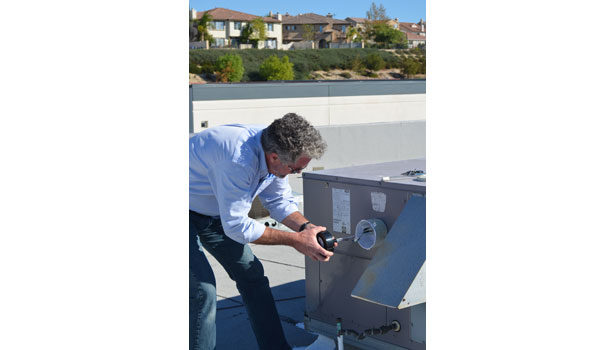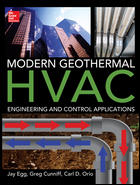The ultraviolet-C (UV-C) wavelength (254nm) was promoted in the mid-1990s primarily to improve indoor air quality by preventing microbial buildup on HVAC cooling coils, air filters, and duct surfaces, and in drain pans.
That said, UV-C technology is often misunderstood and under-utilized by HVAC contractors. Therefore, we’ve assembled some frequently asked questions and answers about the ultraviolet-C wavelength.
1. How large is the UV-C Market?
Virtually all commercial a/c systems are candidates for UV-C equipment because of the key benefits it offers, including: (i) the restoration and preservation of system capacity; (ii) greatly improved indoor air quality; (iii) reduced maintenance; (iv) destruction of airborne microorganisms. According to several sources, the installed base of a/c equipment in the United States puts the market size for UV in the billions of dollars. For the most part, HVACR contractors would control that growth just as they do with other ancillary products shown to be of benefit to their customer base. Anecdotally, roughly one-third of all OEM HVAC systems now leverage UV-C in their systems. Just as no one would operate their air conditioning system without a filter, because dirt would clog the coil in no time, the time is coming when no one will operate their air conditioner without UV for the same reason.
2. How much energy does UV-C save, and is it cost effective for retrofits?
On average, the addition of UV-C energy to an HVAC system can reduce energy consumption by up to 35 percent, while improving airflow/comfort levels. It’s important to note though, that UV-C by itself doesn’t save energy; rather, it restores the coil’s performance. When operating as new, the coil regains system capacity, reducing power consumption. According to the U.S. Department of Energy (DOE), HVAC equipment accounts for between 30 to 50 percent of a building’s total energy use, so the potential dollar savings can be significant.
As a/c equipment ages, it is generally agreed that its capacity, or the system’s ability to remove heat from the air, becomes compromised. Typically, the inefficiency primarily results from the buildup of contaminants on, and through, the coil’s fin areas. A fouled coil is not always obvious by appearance alone especially coils recently cleaned. If an a/c system is no longer handling the load, it is most likely that a fouled coil is the problem. If a coil looks good, but there are still questions about whether it is fouled, that can be determined by measuring airflow and comparing it to the original design. The correct way to make the determination would involve using a traverse, which should then be combined with the air entering and leaving wet bulb temperatures (see the equation below). Dirty coils not only reduce air volume, they severely impede the temperature differential (TD or Δt) across the coil, which results in higher air leaving wet bulb temperatures (or in other words, less water is being removed from the air). As stated, when a coil is partially fouled, it also results in a higher coil pressure drop; this commonly results in less airflow. When airflow is reduced and space humidity is elevated, the conditions will typically bring about poor IAQ levels and occupant complaints.
System capacity consequences from dirty coils can be seen in the ASHRAE equation: Btu’s (capacity) = cfm • 4.5 • (h1 - h2) where h1 and h2 are air entering and air leaving wet bulb temperatures in Btu’s per degree. In the equation, we also see that if cfm is reduced, capacity is reduced. Moreover, working with the numbers shows that even very small changes can have a dramatic effect. In other words, both conditions “must” remain at as-built parameters in order for a system to perform as originally designed.
With a fouled coil energy use must increase in order to compensate for this loss of capacity. With DX systems, the increase stems from more energy used at the compressor and fan, and system run times are dramatically increased. In chilled water systems, added energy is used at the chiller to make lower water temperatures, and to increase refrigerant volume (pumps). At the air handler, fans are sped up or VFDs automatically adjust up to overcome higher coil pressure drops and reduced temperature differentials.
Importantly, UV-C by itself doesn’t save energy; rather, it restores the coil’s performance to regain system capacity by 10 - 35 percent and more. And, as system capacity increases, the energy that had been wasted to compensate for lost capacity is returned in the form of lower power consumption by the system.
Users frequently report that UV-C installations are very cost effective. Many see paybacks in less than six months on energy calculations alone. But when coil cleaning and other reductions in maintenance, occupant complaints and call-backs are factored in, paybacks are often reduced much further. What’s more, it has been estimated that a UV installation costs no more, and often less, than a single professionally performed coil cleaning.
3. What is the ASHRAE recommended minimum UV-C dosage level?
ASHRAE has published the benefits of UV-C energy in its 2008, 2011, and 2012 Handbooks with more on the way. In its 2011 Handbook, Chapter 60.8, ASHRAE’s UV-C committee established minimum irradiation levels for cooling coils to, and we quote: 1) “eliminate mold and bacteria,” 2) “reduce and/or eliminate coil cleaning,” and 3) “sustain coil performance.” Further, it states “use of UV-C can increase airflow and heat-transfer coefficient and reduce both fan and refrigeration system energy use.” These benefits were found to be obtained using 50-100 µW/cm2 (microwatts per square centimeter) striking all areas of a coils surface, and that became the published recommendation. See below.
4. How are HVAC UV-C applications properly sized?
Using ASHRAE’s microwatt recommendations above, HVAC contractors can make use of properly marked UV-C lamps and published lamp data to determine the minimum number of lamps required to maximize the energy saving and system performance benefits of UV-C energy. UV-C lamps have been typically installed 12 inches away from the coil surface, although field experience verified that distances from 3 - 30 inches will work fine. To be clear, achieving 100 µW/cm2 at the farthest away corners of a coil will result in higher numbers in the middle. As a side note, this tends to increase the killing of microorganisms in the air as most of the air goes through the center of the coil. To work all of the way through the procedure requires too much space in this article (see this link http://www.esmagazine.com/articles/96161-illuminating-info-uv-c-for-hvac for additional details).
That said, it has been found that an 80 Watt, 36-inch high output UV-C lamp met all of the ASHRAE criteria on a coil that was 1 meter square, or had 10.76 square feet of surface area. If the lamp wattage is divided by the square footage of the coil surface (80/10.76) = 7.43, we see that about 7.5 lamp watts per square foot of coil surface area will more than meet the ASHRAE recommendations. This then provides a simplified way for contractors to properly size UV installs for most any coil, large or small.
The benefits of UV-C are rapidly expanding its market. Contractors are finding that it solves many of the issues their users are faced with, whether it is capacity problems, maintenance costs, or indoor air quality issues. UV-C can help even though it sounds a little too good to be true. But those who give it a try stick to it and often become evangelists of the technology.
Publication date: 1/6/2014
Want more HVAC industry news and information? Join The NEWS on Facebook, Twitter, and LinkedIn today!









